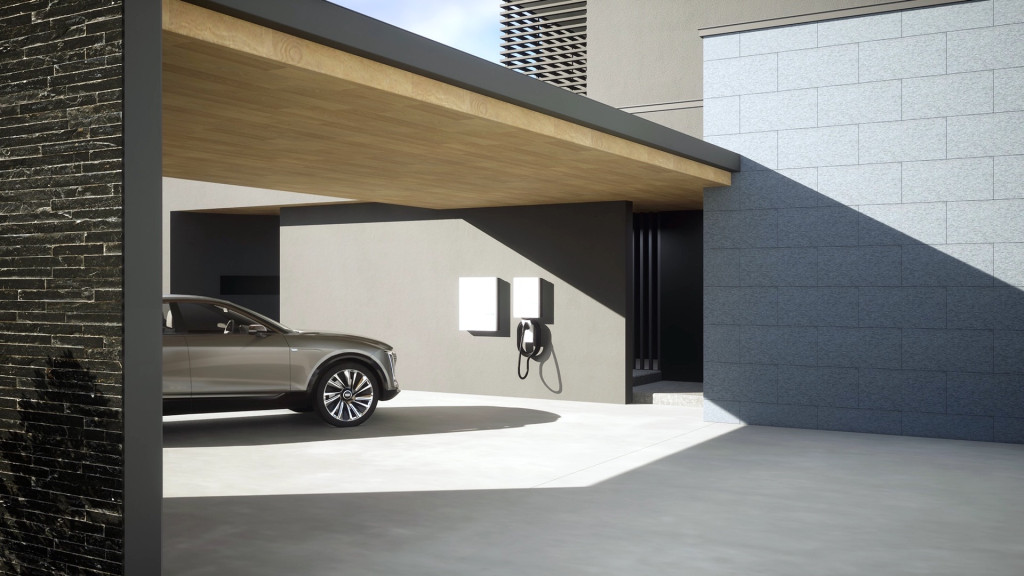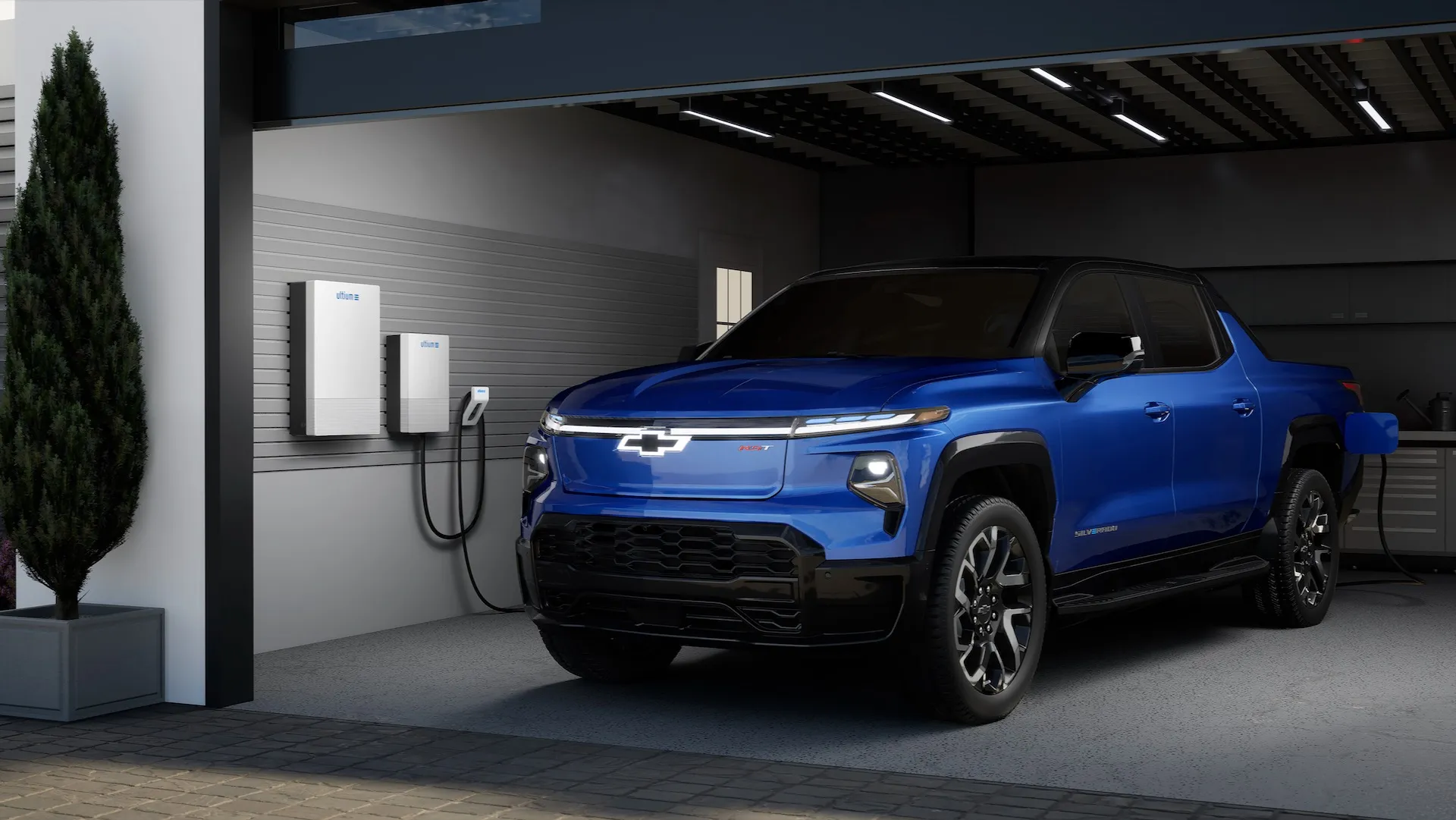GM last week announced details regarding its vehicle-to-home (V2H) system, set to launch with the Chevrolet Silverado EV RST, that will help EV owners back up their home without the help of a storage battery like a Tesla Powerwall or a backup generator.
It’s ultimately part of GM’s big energy play that sees EVs becoming home power banks and more. Trucks like the Silverado EV are literally huge mobile battery packs, with this truck’s massive 205-kwh capacity the equivalent of 15 Powerwalls; even making a small portion of the pack available should be enough to power an American home for days.
According to GM the V2H bundle will initially only be available for purchase in California, Florida, Michigan, New York, and Texas. “We are closely tracking interest in other states and laser focused on delivering an unparalleled experience for our customers, and we will be able to share more about the availability of the products throughout the U.S. in future updates,” said spokesperson Sanaz Marbley to Green Car Reports.
GM Energy app
The automaker has a bigger vision for the product. GM once again noted with the announcement that it plans to expand V2H bidirectional charging technology across all its Ultium-based EVs by model year 2026. It confirmed that the 2024 GMC Sierra EV Denali Edition 1, 2024 Chevrolet Blazer EV, 2024 Chevrolet Equinox EV, 2024 Cadillac Lyriq, and the future Cadillac Escalade IQ will also be part of that rollout. It’s more recently clarified that these products won’t be walled off to a GM Energy app, as previously envisioned (above) but instead as part of their respective brand apps—for Chevy, GMC, or Cadillac, for instance.
In the case of the Chevy Blazer EV, for instance, GM has already confirmed that models delivered from the start have all the hardware needed for compatibility with these GM Energy components, but the software to use it won’t be in place until sometime later in the year.

GM Energy home bundle – displayed with Chevy Blazer EV
Batteries included, other hardware needed
The GM Energy Powershift Charger that’s initially mandatory to access the vehicles’ bidirectional functionality will cost $1,699. It’s good for charging at 19.2 kw AC, while discharge power from the unit is DC and peaks at 9.6 kw.
The other necessary piece, the V2H Enablement Kit, costs $5,600 and includes an inverter, a grid disconnect switch, and the 12-volt dark-start battery necessary to move the contactors in the case of a power outage. That brings the total component cost to $7,299.
For those who want it all on the GM ecosystem, GM Energy stationary energy storage and solar integration will both also be available for purchase starting later this year.
GM cautions that installation costs for the equipment are based on a number of factors, including where you live, the age of your home and electrical panel, the location of the panel, and your servicing electric utility.

2024 Chevrolet Silverado EV with GM Ultium Home energy system
Chevy V2H: Like Ford, leave thousands for installation
GM is by no means first-on-market with this functionality, as the Ford Home Integration System has already been available for nearly two years, Working with the Charge Station Pro, which is already included with large-pack versions of the F-150 Lightning, it includes hardware that perform those same roles, allowing owners to use energy from their truck to back up the home. Tesla is also offering a Powershare feature with the Cybertruck—permitting 11.5 kw of home backup power through the charge port and claiming no additional equipment would be needed for homes already equipped with a Powerwall and its Wall Connector. Tesla points to a typical installation cost of $2,000 to $3,500 excluding the cost of the equipment, which would at minimum be a $1,800 Gateway in addition to a compatible wall connector.
Ford’s installation of the home system relies on solar provider SunRun. A page from SunRun which appears to have been updated since the original launch, now says the system costs $8,900 to $9,400 to install including the Ford ChargeStation Pro, which may be a redundant piece. Ford originally told Green Car Reports that a best-case-scenario installation—not requiring a new panel or service upgrade—would cost about $6,000 including the hardware. Ford hasn’t responded about updated installation costs for the system, and based on other reports and feedback from owners it’s likely to cost thousands more for many households.
EV home backup and the shift to Tesla NACS
The other big question that’s been left unanswered by GM is whether this system would be forward-compatible with other EVs, via an adapter, after GM switches to the Tesla-based NACS connector. As NACS has been standardized, it does support V2X technologies, so while there will be workarounds within the standards, it’s not yet been spelled out by any executive, as far as Green Car Reports is aware, as to whether or not this would require a new generation of hardware.
As of yet, the list of other EVs that can power the home is a short one. The Kia EV9 can provide home backup, with hardware from Wallbox, and the Volvo EX90’s bidirectional charging features will be the start of an energy business tapping into its EVs’ bidirectional charging features. Both of these options might shift in hardware, if not functionality, when NACS arrives.

GM Energy – Ultium Home
The other issue, of course, is that the vehicle has to be plugged in to provide home backup power. So if you’re going through a brownout and need to go out on an errand, or if a downed tree keeps you from reaching your garage, it means no power. For this scenario, it’s likely some homeowners will, in the future, be combining V2H vehicles with even smaller battery backup.
If that’s enough unease to stick with whatever EV you’re driving at this point, the Powerwall is currently at $9,300, minus a 30% tax credit plus installation. So while the hardware goes through yet another iteration, potentially, simply backing your home up with a Tesla Powerwall might be cheaper and a safer bet at the moment—if you don’t need to move your battery backup around on wheels.
Read the full article here




